

COZY SWEATERS. FALLING LEAVES. EVENING BONFIRES.



COZY SWEATERS. FALLING LEAVES. EVENING BONFIRES.


THE RUBICON PHOTO: Sam Galarneault
POWER POSE. Seniors Cassandra Overholt and Josh Holloway will serve as the Spartan for 2024-2025. Homecoming is a busy season for the mascot, leading the Spartan Beat at games, visiting the lower school pep fest, and leading the charging of the field. BRONZE HELMET GLOWING SWORD HERO’S CAPE BREASTPLATE ANKLE GUARDS
WHAT DOES IT TAKE TO BE A GOOD MENTOR?
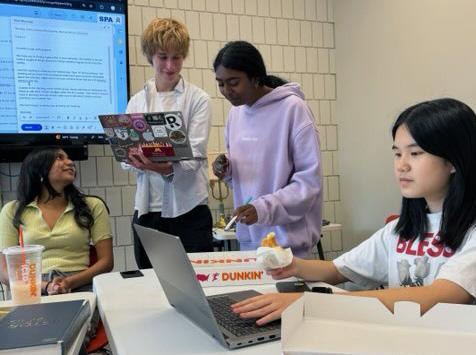
THE RUBICON PHOTO: Georgia Ross QUALITY TIME SPENT. Cerena Karmaliani, Evan Morris, Shefali Meagher, and Carys Hsiung worked to design an application that defines the characteristics of a strong mentor.
Engagement: Mentors should show interest in various school activities and demonstrate well-roundedness.
Initiative: Mentors should plan informative and supportive meetings.
Commitment: A quality mentor is committed to the program and its mission. They are enthusiastic and available to their mentees.
It’s that time of year celebrated by kindergartners and alums alike: Homecoming Week.
The highest-energy week of the year offers grade-level contests, dress-up days, and home games for fall teams.
Junior representative Raina Heidkamp said SAC’s primary goal is to select activities that prioritize the theme and encourage participation.
“[Homecoming] is so early in the year it can definitely set a tone for how the community bonds and interacts with one another for the rest of the year,” Heidkamp said.
SAC advisor Rachel Yost-Dubrow ensures the group executes its ideas efficiently.
“I make sure that everyone gets heard… to make sure their vision becomes a reality mostly by just helping people figure out who needs to do what,” she said.
When planning Homecoming Week, there are many factors to evaluate, such as different themes, games, activities and dress up days.
Heidkamp, serving her third year on the committee, said that the objective when planning Homecoming Week is to create a fun and safe space for the student body to bond outside of class.
Planning multiple events for every day means extra time for committee members.
“We sometimes have to come to school earlier or later depending on the help needed to plan certain events but it all is worth the time and effort,” SAC Treasurer Flo Barrera said.
This year, Barrera leaned into the spirit of the season to pitch a dance theme.
The final event of the week, Saturday’s dance, Cider & Spice, is advertised with a autumnal color palette.
After agreeing on Barrera’s starting point of autumn, SAC relied on collaboration to bring the concept to life.
“Everyone brought ideas and thoughts to create a bigger picture,” Barrera said.
Homecoming week started on Monday, Sept. 23 and will continue until the dance on Saturday, Sept. 28.
Monday Ping pong tournament
Dress up: USA OUT Tennis at 4 p.m.
Tuesday
Assembly
Dress up: Class colors GVS at 4 p.m.
Wednesday Dodgeball Dress up: Rhyme without reason Volleyball at 7 p.m. SPARKS at 7 p.m.
Thursday Senior Speeches Dress up: Cozy sweater XC at 4:20 p.m.
Friday Pep Fest Dress up: Blue & Gold Carnival Storm Lang Field BVS at 4:30 p.m. Wolfpack at 6 p.m.
Saturday GVS at 1 p.m. Cider & Spice dance
GEORGIA ROSS CHIEF VISUAL EDITOR
New to SPA? Meet your mentor.
A program that in past years paired all ninth graders with a senior has expanded to include all new students. As a result, every senior who applied to be a mentor was assigned a mentee.
On Aug. 21, mentors and mentees met each other at the ninth grade retreat, where rising freshmen were introduced to the upper school through dyads, student panels, and a mentor-mentee lunch.
Ninth grader Olivia Fox described the program as a chance “for kids to have a connection.”
For decades, the standard was for a junior or senior to be paired with a group of up to four freshmen. But as the program welcomes more mentors, the ratio is closer to 1:2.
USC members aim to pair students with similar
interests and sometimes allow pairings that mentees requested.
“
[OUR
HOPE IS FOR] MORE SENIORS TO HAVE A PLACE IN THE SCHOOL AND [THAT] THEY’RE CONTRIBUTING.
senior Cerena Karmaliani
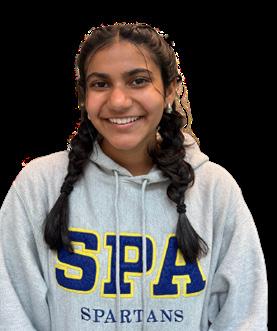
Conversation topics can range from academic to social, including time management and how to dress at school events.
Most of the program is unstructured and in the hands of the students. Mentors must meet with their mentees at least once a month, but the hope is that a successful match will be eager to
meet more often in unscheduled times.
“It has been nice to have someone to sort of be able to look up to,” Fox said. “[My mentor has] done very well and has tips.”
USC received over 90 applications for 40 spots this year, so chose to restructure the application evaluation to reflect interest.
“[Our hope is for] more seniors to have leadership positions and feel like they have a place in the school, and [that] they’re contributing,” USC co-president Cerena Karmaliani said.
Senior Inga Wing appreciates the partnership between mentors when balancing conversations.
“I think it’s easier … because if you don’t really know what to say, then the other [mentor] knows what to say, and vice versa,” she said.
USC hopes the program’s mentorship of-
fered to new students this year will make junior and senior mentees feel welcome in the community.
“Adjusting to high school isn’t just for freshmen … people getting thrown into a new environment aren’t just freshmen,” Karmaliani said.
However, the change has demanded a certain level of pairing intentionality, especially when pairing new juniors or seniors with mentors of the same age.
USC hopes that mentees, especially non-freshmen, can utilize access to a mentor in a way that works best for them.
“A good portion of the juniors who are new requested somebody in their grade, and we try to do that,” Karmaliani said.
“We did kind of leave that space open.”
USC plans to monitor the changes as the year progresses by sending feedback surveys to the mentors and mentees.

Minnesotan Annie Sperling recently authored a cookbook called Good Grief! What’s For Dinner? Sterling, who joined a widows’ group in the Grief Club of Minnesota after the death of her husband, features recipes submitted by other support group members in the collection. The book aims to aid those who are dealing with loss with easy recipes that honor the memories of their deceased friends and family.
GRACE MEDRANO
THE RUBICON DONUT SPEED-EATING. A student from each grade level and a faculty member participated in the “Donut on a String” competition during X period on Wednesday, Sept. 8. The donut activity was part of the larger implementation of weekly assemblies this year. “I do wish it didn’t take up all of X-Period,” sophomore Anneli Wilson said.
Starting this school year, students leave their lunch or second-to-last class every Tuesday afternoon and head towards the Huss auditorium for the new weekly assembly.
Assemblies were sporadic in the past. Outside of weekly senior speeches, they were not scheduled consistently, sometimes during an X-Period or replacing the 10 minute advisory check-in time on a random morning.
This year, the goal is to remove uncertainty with the timing and purpose of assemblies.
Dean of Students Stacy Tepp said, “It was challenging if we were to call an assembly from 8:00 to 8:10 in the morning --- 10 minutes isn’t a ton of time. Students and faculty wanted consisten-
cy with X-Periods. They wanted that time to make announcements and celebrate with each other, so that’s why we made the decision.”
Senior Ellie Putaski
I THINK [THE WEEKLY ASSEMBLIES] WILL HELP BUILD A SENSE OF COMMUNITY. “

agreed: “It’s nice to have a designated time for students to make whatever announcements we want. I think it will help build a sense of community.”
The new assemblies aim to provide more
BREAKING NEWS of the month @therubiconspa
Internet service update slows wifi, forcing students to swap screens for paper
WORK WITHOUT WIFI. On Sept. 10, internet speed at the Randolph campus was slow as a result of service maintenance. Students were left to navigate their school work without wifi. Seniors PJ Bohjanen and Liam Sullivan ditched their computers to complete their math homework on paper. Senior Deling Chen, however, took a different approach: “I’m depending on my [mobile] hotspot so I can do my homework.”
Scan this QR code

community building. Events like House Cup, which engage students in friendly grade rivalry, have already garnered class engagement.
The grade-level House Cup competitions have included cup stacking and eating donuts on a string in September. Currently, the junior class is in the lead at 100 points.
Assemblies have offered a space in the day for weekly announcements, replacing most 8 a.m. meetings, which were sporadically attended.
Students and faculty line up along the stage and pass a microphone, sharing news about sports, extracurricular activities, and upcoming class events.
While students have expressed excitement for the change, some are less


pleased with the development.
Sophomore Anneli Wilson said, “I think that giving students a chance to make announcements every week is good, but I do wish it didn’t take up all of X-Period.”
Tepp hopes students will approach these assemblies with an open mind and try to make the most of them.
“I hope that it will feel like a time when we’re having fun and celebrating with each other,” Tepp said. “That’s what it’s really meant to be.”
The weekly X-Period schedule includes: Monday - elected/selected or class meetings, Tuesday - assemblies, Wednesdayadvisory, Thursday - clubs or affinity groups, Friday - senior speeches.
After over 230 school shootings in ten years, bulletproof technology is being integrated into hoodies, backpacks, and more by big companies like 3M. The issues: they’re expensive (imagine paying $185 for a pencil case), and it hasn’t yet been proven that they improve safety. The New York Times reports that the public is skeptical about the effectiveness of personal objects like clipboards and pencil cases, but some items, like desks and backpack inserts are more reliable. At the building level, companies offer items including collapsible safe rooms, window film, and bulletproof dry-erase boards that can be installed in classrooms to heighten protection from gun violence.
The return of wild boars to the area of Loch Ness in Scotland has affected locals in more ways than one. Drivers are confronted by boars; farmers are discovering dead lambs on their land; lawns are being torn to pieces. Boars eat a majority of roots, but also feed on small animals like lambs, pheasant, and small deer. They were hunted to extinction, but later were brought back in small numbers and escaped captivity, growing their population of unregulated levels. If the situation is not controlled, the boars will have negative effects on the environment and property. As long as the boars are contained in forests and away from landowners, they can roam in harmony with Scotland and the people living there.


PRESIDENTIAL SHOWDOWN. Former President Donald Trump and Vice President Kamala Harris faced off in the presidential debate on Sept. 10. “It just felt more like how a presidential debate should feel,” senior Olympia Wolff said.
KHARBANDA THE RUBICON
Abortion, immigration, the economy, and the Israel-Hamas war were among the topics discussed during the Sept. 10 presidential debate between former President Donald Trump and Vice President Kamala Harris.
Senior Olympia Wolff was impressed by Harris’ performance, as well as the professionalism compared to the last debate.
“I appreciated the way [Harris] differentiated herself from Joe Biden,”
“I trust that
AARUSHI BAHADUR
In the month since Tim Walz was chosen to be the Democratic vice presidential candidate, he has catapulted to national stardom. From attending fundraisers to turning on his all-American everyman charm to headline the third night of the Democratic National Convention in Chicago, eliciting rapturous applause, Walz has changed the conversation about what it means to be a Democrat overnight.
Wolff said. “It just felt more like how a presidential debate should feel.”
The debate, held at the National Constitution Center in Philedelphia and hosted by ABC News, marked the first meeting between the candidates, after Harris’ quick entry into the race on July 21 following President Joe Biden’s disastrous performance in the June presidential debate.
The candidates each had two minutes to answer questions on a specific topic given by the
moderators, David Muir and Linsey Davis, followed by one minute to respond to each other in a space without an audience. Much of the debate was broadcast in split screen between Trump and Harris, with their reactions on full display.
Director of Debate Marrit Warren observed that “the moderators in this particular debate were really effective at both keeping time and keeping the rules of the debate going and some limited fact checking in
real time for some of the more shocking claims made,” she said.
The moderators factchecked Trump’s assertions that it is legal in some states to execute babies after birth, and that immigrants are eating cats and dogs in Springfield, Ohio – both are untrue. Many news organizations later released a complete fact-check of the presidential debate, which included claims that lacked evidence, exaggerations and misleading claims on both sides. For example, Harris criticized Trump for leaving the Biden-Harris administration with “the worst employment since the Great Depression,” although, when Trump left office, unemployment was at 6.4%, which is not the highest rate since the Great Depression.
Junior Zain Kizilbash wished that more policy was discussed, as opposed to name-calling.
“Most of the debate was spent attacking the other side, instead of focusing on why you should vote for the spe-
cific candidates,” he said. “I feel like [that’s] a bit of a problem just because things get so polarized that way.”
Similarly, Warren noted the differences between political and school debates; she sees political debates as more of a marketing opportunity rather than an explanation of policies.
I THINK WITHOUT THE JUNE DEBATE, BIDEN WOULD STILL BE THE CANDIDATE.

“You’re not working to ... convince someone about one particular issue or policy. You’re trying to convince them to like you,” Warren said.
Harris often spoke directly to viewers, appealing to voters with personal stories and her vision to lead a future-focused na-
tion. Meanwhile, Trump’s strategy appealed to fears about border security and immigration. The policy discussions allowed viewers to compare the candidates’ economic plans and foreign policy for the Ukraine-Russia and Israel-Hamas wars. Harris put forth a tax cut for young families and start-up businesses, while Trump explained his sales tax. However, policy explanations were overshadowed by disagreements about the facts. For example, Harris cited several economists’ critiques of Trump’s sales tax, a claim which Trump disputed. While the soundbites have gained more traction than any policy on social media, Kizilbash still believes these debates have an impact. “I think without the June debate, Biden would still be the candidate,” Kizilbash said.
The vice presidential candidates, Minnesota Gov. Tim Walz and Senator J.D. Vance (R-Ohio), will debate on Oct. 1 on CBS News.
DIR. OF RUBICONLINE [...] When he suddenly became the [...] vice presidential candidate, I learned a lot about him.”
HE’S TRIED TO HELP EVERYONE, AND I THINK THAT REALLY SHINES THROUGH “

Walz’s rise was a pleasant surprise for Minnesota Democrats. Walz briefly received flashes of national recognition during his time as governor for his free student lunch policy and the codification of abortion protection in the state; however, his unassuming presence kept him out of mind for many students.
Junior James Welsh voiced the general consensus about student knowledge on Walz prior to this summer. “I’ve been following him loosely since he became governor of Minnesota. I mean, he generally seemed like a good guy, but I just didn’t know that much about him.
Walz joining the presidential ticket highlights the significant effect of President Biden’s historic withdrawal from the race. The new ticket has re-energized Democrats, resulting in increases in favorability polling, volunteers and donations. The governor’s first month as his party’s vice presidential nominee has raised optimism among Democrats about their prospects in swing states, including Wisconsin, Michigan and Minnesota. “Throughout his career, he’s tried to help everyone, and I think that really shines through, whether it’s providing free meals for all public
school students, or being one of the most proLGBTQ governors in all of the states,” Welsh said.
Senior Belle Weng will be a first-time voter this fall. Weng was largely indifferent about voting before this fall, describing herself as part of the crowd that gets drawn into following politics when election season starts to ramp up. As a result, like many ordinary voters, she didn’t take notice of Walz until now.
“I knew his name when he first became governor, but I didn’t really know his policies until recently,” said Weng.
Having a Minnesota official on the national stage has also increased her political awareness. His proximity and familiarity to Minnesotans has resulted in greater discussion of the election, allowing Weng to absorb more information than she would otherwise without intentionally researching the candidates.
Though Walz’s nomination for vice president would not determine her overall vote, she feels that, as with her experience of increasing her political engagement with his nomination, Walz’s Midwestern roots could
sway Minnesotan voters. “[He’s] someone who’s familiar, someone who’s done things in the state that were tangible. It’s like, ‘Oh, I trust that guy’.”
Tim Walz’s unusual background as a former history teacher, football coach and member of the military has aided Democrats in flipping a historically Republican narrative to appeal to more moderate voters.
“Democrats are trying to reclaim more rural voters, mostly older white men, which is a demographic that tends to skew Republican, so someone who won a traditionally Republican district, who was a football coach and who gives an alternative, far less toxic version of masculinity, being on the ticket is an appealing idea,” said Government and Citizenship teacher Aaron Shulow, who has followed Tim Walz’s career since he first was elected to the House of Representatives for Minnesota’s 1st congressional district in 2006, defeating six-term Republican incumbent Gil Gutknecht.
Weng agreed. “I think a lot of the Republican rhetoric is [that] Democrats are not American
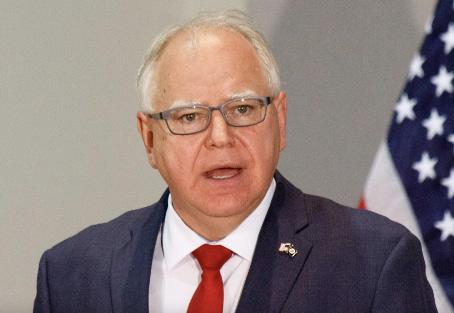
enough. But he’s your staple American man who has…done all these things that are very typically masculine. ... What can you pick at him for?”
But, as Democrats hope, he’s the next best thing in this election.
Not all of Walz’s appeal lies in his background or policies, though. “People were turned off by politics in part because it seemed like there’s going to be another rerun between two old white men. Tim Walz seems, whatever you think of his policies, authentic and joyful, and people responded to that positive energy,” Shulow said.
Whether Walz is suc-
cessful or not in swaying voters will be difficult to determine, as most people don’t make their decision for President based on the VP pick. However, in what could be an extremely close race, Walz may have just enough charm and moderate appeal in swing states, such as Minnesota, crucial to Democratic success in November’s election.
online

OUR MISSION
We strive to capture the spirit of the community through its stories while inspiring deeper conversations. Above all, we stand for integrity in our pursuit to inform and engage our readers.
THE RUBICON
St. Paul Academy and Summit School 1712 Randolph Ave • St. Paul, MN 55105 rubicon.spa@gmail.com www.rubiconline.com @TheRubiconSPA
24-25 STAFF
EDITOR-IN-CHIEF
MANAGING EDITOR
CHIEF VISUAL EDITOR NEWS EDITORS
OPINIONS EDITOR IN DEPTH EDITOR FEATURE EDITORS
SPORTS EDITORS
A&E EDITOR
MIXED MEDIA EDITOR
COPY EDITOR CARTOON EDITOR THE RUBICON
Annie Zhang
Juan Miguel Adams
Georgia Ross
Johanna Pierach
Gavin Leuthold
Sonia Kharbanda
Amanda Hsu
Grace Medrano
Lina Abid
Sam Galarneault
Peter Ostrem
Annika Kim
Ivy Evans
Alba Markowitz Mulet
RUBICONLINE
DIRECTOR OF RUBICONLINE
PRODUCTION MANAGER
MLP BEATS MANAGER NEWS EDITORS
OPINIONS EDITORS
FEATURE EDITORS
A&E EDITORS
SPORTS EDITOR
PHOTOJOURNALIST
CREATIVE DESIGN MANAGER
RUBICONTV
PHOTO EDITOR
SOCIAL MEDIA MANAGER
Aarushi Bahadur
Greyson Sale
Thomas Chen
Allan Wang
Peter Lipinsky
Audrey Jansen
Lani Ngonethong
Lucy Thomas
Nabeeha Qadri
Andrew Lipinsky
Yassin Mokbel
Tamari Christopher
Elizabeth Tuttle
Audrey Peltier
Zimo Xie
Nora McKoy
Murphy Miltner
Mariam Malik
Winston Arvidson, Sunde Auberjonois, Tallulah Dogwill, Jack Gao, Jack Gordon, Luca Kempcke, Ariella Kim, Chloe Kovarik, Harper Larsen, Shrey Nemani, Ike Obi-Walker, Alyda Overgaard, Juliet Pickens, Aiden Ruediger, Sylvia Westra
ADVISER
Kathryn Campbell, CJE
PUBLICATIONS ASSISTANT Helen Feng
MEMBERSHIPS Columbia Scholastic Press Association

INSPIRE ACTION. Land Acknowledgments serve to spread awareness about the Indigenous communities that inhabited this land and remind listeners of Indigenous peoples’ ongoing presence. Students have a responsibility to take these Land Acknowledgments seriously and advocate for further restorative actions.
CURRENT PUBLICATION AWARDS
On the same land where students now await test scores and celebrate homecoming, the Indigenous communities of the Dakota as well as the Ojibwe once lived. These Indigenous peoples thrived off of the land before it was forcefully usurped by European settlers, resulting in the displacement of these Native nations from their ancestral homes.
A well-written, respectful Land Acknowledgment serves as a formal statement recognizing Indigenous communities as the original proprietors of the land and their continued relationship with the territories. Beginning in Canada during the 1970s, Land Acknowledgments have spread worldwide, often shared aloud before events and created for schools to implement in their classes.
Based on the reality that one paragraph cannot be tasked to solve a 248-year-long conflict, many have taken the stance that Land Acknowledgments only fulfill a performative obligation. Contrary to the notion that Land Acknowledgments are merely a formality, they help the audience understand the origins of the land, which, in turn, generates steps toward meaningful change. One positive outcome of this change involves educating students about the retribution of land, an important aspect of Indigenous history.
topic, participating in reparative actions, supporting Indigenous rights, and collaborating with communities to restore Indigenous land.
Land Acknowledgments do not only serve the purpose of eventual land retribution but also acknowledge that Indigenous communities are still prevalent. Indigenous people and practices are mainly taught in history classes.
Consequently, some students associate Indigeneity with the past. Thus, a Land Acknowledgment can serve as a reminder of these communities’ ongoing presence and contribution.
However, not all Land Acknowledgments can yield benefits for their audience. There are pitfalls in creating meaningful Land Acknowledgments. Many miss the mark in conveying that the land was stolen and do not address who was at fault. Furthermore, acknowledgments should be vetted and have a comprehensive process and partnership with Indigenous voices. For example, the SPA Intercultural Working Group in the lower school designed a Land Acknowledgment and took the initiative to incorporate an Indigenous perspective. From that conversation, it became clear that further revisions were required.
While the Land Acknowledgment will not prompt an immediate fix to the land usurped from Indigenous communities, it serves as a beginning first step.
Without the proper knowledge of how the land students live on came to be, change can’t transpire. By acknowledging the original owners of the land, students can begin to question the long-term effects of settler colonialism and its impact on Indigenous peoples.
Furthermore, listening to a Land Acknowledgment can make an audience more likely to recognize their responsibility in advocating for tangible change. Human reflection prompted by a thoughtful Land Acknowledgment can lead to further education on the
Land Acknowledgments alone are not enough; they require meaningful action from students. Activism would include actively learning about Indigenous history, advocating for Indigenous representation in our curriculum beyond history courses, supporting Indigenous led-initiatives and businesses, and building partnerships that uplift Indigenous voices.
This is only the beginning of learning more about what individuals can do. The Intercultural Working Group has taken an essential step in incorporating Indigenous voices, but the effect of a Land Acknowledgment depends on our student body.
It’s now up to us, with or without guidance from the administration, to decide: will we amplify Indigenous voices and take tangible steps toward reconciliation, or let a future acknowledgment remain empty words?
Statements like “I’m so OCD,” “I’m depressed” and “I’m so bipolar” are frequently heard on social media and among teenagers. The problem with these casual claims is that often, people are sharing their immediate emotions, and not longterm mental health conditions. In recent years, mental health has become a national conversation and in most ways, that’s a positive change. It’s led to more awareness of mental health, but it has also resulted in some people exaggerating their conditions and ignoring the severity of mental illness, especially on social media. Since it’s such a common topic, people feel like they can use it as a joke, or diagnose themselves with anxiety or depression when they’re really just feeling nervous or sad. As a result, people who face mental health conditions may be taken less seriously.
Teenagers have mixed views on how social media affects their mental health. According to data from Surgeon General Vivek Murthy’s advisory on social media and youth mental health, 46% of youth ages 13-17 stated that social media makes them feel worse about their body image. On the other hand, the National Center for Health Research noted a 2022 survey in which 32% of adolescents said that social media has a mostly positive impact on their life.
“
ONLINE, IT IS EASIER FOR PEOPLE TO MAKE JOKES ABOUT MENTAL ILLNESS
junior Peter Ostrem

Despite these varied perspectives, social media is a large contributor to the destigmatization of mental health. Online, it is easier for people to make jokes about mental illnesses and spread misinformation. An influencer can post something false about symptoms of depression on TikTok, and thousands can view the content and believe that they have depression. Social media has led to a lot of teenagers using TikTok or Instagram as their first source of information, instead of going to a reliable source. Mental health is much more serious than most social media influencers make it out to be.
Still, people who are struggling with mental health can feel more seen due to the increase of representation and conversation about mental health on various

INTERNET INVALIDATION. Jokes and generalizations about mental illness are common on social media. These comments can make light of the seriousness of mental health, making people who are struggling feel misunderstood.
platforms. In a 2022 study of about 1,300 U.S. teenagers by the Pew Research Center, 58% responded that they feel more accepted with social media, and 67% said that social media can help them through tough times. The openness to discuss mental health is not the problem, nor is finding a community online--the problem lies when social media replaces a trusted doctor providing a diagnosis or offering treatments.
Mental health has been too destigmatized on social media. There are far too many insensitive jokes and generalizations, as well as a lack of knowledge of how to use specific terms. When discussing mental health on social media, make sure to use the right terms, and be sure to not spread misleading information.
SAM GALARNEAULT THE RUBICON
With the start of new classes, extracurriculars and schedules comes the opportunity to build habits to maintain throughout the rest of the school year.
A long-lasting habit is a task one adds and performs in their routine regularly until it eventually becomes instinctive. Sustaining healthy habits is a crucial part of maintaining a healthy lifestyle in and outside of school.
One common long-lasting habit that is beneficial for people of all ages is going to bed at the same time every night and waking up at the same time each morning. For students, another healthy habit would be meeting with teachers regularly or prioritizing finishing homework at the same time every day. When a student maintains a regular routine, they can find themselves feeling mentally and physically happier and stronger.
Researchers from University College London wrote in a 2012 publication about the effect of long-lasting
PUBLICATION INFO The Rubicon is published eight times a year. We distribute 450 copies of each issue to the Upper School which are available for free.
ADVERTISING The Rubicon does not accept advertisements.
ANONYMOUS SOURCES Although it is always preferable to use names when reporting, there are times when it is necessary to protect those we report on. In the case of a student, the use of grade level as a name designation will be the preferred method of anonymity.
BY LINES credit the individual who conducted interviews, drafted, revised and fact-checked an assigned story. Shared bylines are given to joint effort

HELPFUL HABITS. Take the beginning of the school year as an opportunity to establish consistent routines, such as going to bed at the same time every night.
habits versus short-lasting habits and concluded that sustaining a long-lasting habit to improve one’s wellbeing benefits health. “Forming one ‘small’ healthy habit may thereby increase self-confidence for working towards other health-promoting habits,” authors Benjamin Gardner, Phillippa Lally and Jane Wardle wrote. Psychologists call this habit-formation.
assignments. Stories that include supplemental materials include a credit at the bottom that states “Additional reporting by” followed by the name of the reporter.
EDITORIALS articulate the collective opinion of The Rubicon staff, while mini-editorials, opinions pieces, arts reviews, and columns belong to the author.
SUBMISSION GUIDELINES
Opinions are welcomed as Letters to the Editor or Submitted Opinions and may be published in the print or edition. Letters to the Editor should not exceed 400 words and Submitted Opinions should not exceed 650 words. Both may be edited for length and style. All pieces must be submitted and
will be published with a full name.
UPDATES AND CORRECTIONS
During the post-critique process, staff members identify inaccuracies and report feedback from readers. The staff publishes corrections when an error is discovered during critique or reported to a staff member. Corrections should be directed to the Editor in Chief or appropriate section editor.
IN PRINT: Corrections are printed at the bottom of News p. 2. Corrections will be printed in the month following the error and, if the story is also published online, will be corrected following the online corrections policy.
PHOTO CREDITS Photos taken by staff members are labeled with their
The goal of habit-formation is to create habits that strengthen over time until they become intuitive with very little deliberation. It is a skill that can be implemented into one’s lifestyle to negatively or positively affect one’s routine. Healthy habits in physical routines can look like eating specific food groups everyday or reaching a certain work out goal to maintain physical strength and wellness. However, not all habits are beneficial. Unhealthy long-lasting habits can look like constant attention to one’s phone to the point where it becomes hard to detach when needed.
Almost everyone has long-lasting habits built into their daily routine that keep them healthier, such as brushing their teeth every morning. By creating and maintaining a habit now and staying consistent, later it will be a natural instinct to make healthy choices. Habits aren’t necessarily easy nor will the beneficial effects be realized quickly; some might take more patience and work than others. Even though healthy habits won’t change overnight, they are still important for bettering one’s daily life and are still worth prioritizing.
respective staff. Images sourced from outside of the publications staff are credited information pertaining to their origination.
NAME AND PRONOUN USE
The Rubicon uses the name and pronouns reported by the individual source. Each interview and survey begins with a request to say and spell the person’s name and to share the pronouns they would like to see published in the story, and the reporter is transparent about where the story will be published. If a mistake is made in the course of reporting, a correction will be posted per the corrections policy.
CONFLICTS OF INTEREST The Rubicon news and Ibid yearbook avoid
conflicts of interest while also honoring the fact that our reporters are involved in the school and local community beyond their work on staff. Staff members avoid writing about students, teachers, student clubs, affinity groups, and organizations that they are closely involved with. The reporter is always responsible for disclosing conflicts of interest, and if a conflict of interest comes to light after publication, it does not warrant removal of the story. If it is in the best interest of a source to be interviewed by a close friend in the case of a sensitive topic, the interviewer will not write the story— they will solely conduct the interview. Unavoidable conflicts of interest are specifically mentioned at the top of the story. Photographing news events is never a conflict of interest.

STAR POWER. Celebrities’ and influencers’ political stances can overshadow politicians. Their statements have power to influence an audience, so they must recognize the danger in spreading information.
Moments after the Sept. 10 presidential debate between Kamala Harris and Donald Trump, Taylor Swift posted on her @taylorswift Instagram with an official endorsement for Harris, weighing in on a tumultuous election season.
Why does it make news when celebrities and influencers share political opinions, quietly or loudly advocating for one side or another? The seemingly sudden intersection of social media platforms and political parties highlights how celebrities and influencers can impact politics.
The rise of social media plays a role in widening the influence of media personalities, especially if they take a side on a divisive issue.
The Center for Information and Research on Civic Learning and Engagement found in a 2020 poll that around 70% of young adults interacted with and learned information about that year’s general election through social media.
According to the Pew Research Center, from 2020-23, the percentage of U.S. adults who get their news from TikTok rose more than fourfold; a third of adults under age 30 now get their news through TikTok.
Aside from the growing dependency on media platforms as news outlets, researchers Chao Ding, Wael Jabr, and
Hong Guo discussed in a 2023 study how traditional media outlets promote increasingly more extreme views, leaving moderates or independents to gravitate towards more approachable influencers who accommodate a wider audience.
Influencers have power, and their posts leave an impression or—as their name expresses— influence the people who watch them.
This power can have positive outcomes: introducing people to the political scene, persuading individuals to vote, and educating or discussing current topics that larger political parties usually can’t take a stance on.
With the limitless potential of social media, more people can access and interact with politics in a less intimidating fashion.
Trump and Harris realized this opportunity and started initiatives such as Harris’ “Creators for Kamala” or Trump’s regular posts at Truth Social.
They leveraged the power of celebrity by extening invitations to stars for both the Republican National Convention in and Democratic National Convention, urging more than ever that influencers cover the event on their platforms.
Creators can easily mislead people, proliferate misinformation, spread inflammatory content and unnecessarily escalate situations, especially if a creator has a purposeful narrative in
mind or is a viewer’s only source of information.
The larger the platform of a content creator, the greater responsibility they have to present their information and opinions without causing harm.
THE LARGER THE PLATFORM OF A CONTENT CREATOR, THE GREATER RESPONSIBILITY THEY HAVE. “ junior Amanda Hsu

Public figures outside politics who suddenly unveil how they’re voting when election season rolls around can appear disingenuous or self-interested: seeking to capitalize on the occasion. Sharing political views spontaneously in this manner can change how audiences perceive the character and credibility of a celebrity.
Using celebrity in this way feels different from leveraging a substantial platform to talk about issues or bring attention and donations to a cause, even if they are less knowledgeable about the topic.
There is a significant difference between expressing political opinions and spreading awareness about global issues.
The disbelief that comments from an influencer
ANNALISE ATKINSON CONTRIBUTOR
During time away from classes, students need breaks from school; for many, using phones is the break. Whether it’s scrolling through TikTok or texting friends to find where they are during a common free period, phones are a key part of student’s lives, and taking them away will do more harm than is stated in the phone policy.
A key argument for being a “phone-free” school is that it will lessen anxiety that students feel. Even though certain studies have shown that phones increase anxiety, it is also true that phones can help decrease anxiety. Many people use phones to communicate with their friends after classes so they can meet up to hang out or do homework, but without phones, this is compromised. If students can’t contact their friends during school to meet up, it will end with kids spending more time alone, which can stunt social growth and increase anxiety.
or celebrity can have any effect on their audience’s personal opinions at all is common.
While this may be true for a few individuals who are firmly rooted in their views, hearing and learning about different perspectives and circumstances from anyone in general, let alone a creator, will have an impact, big or small, on most audiences.
Content creators often build their brand on the fact that others look up to and are inspired by them, with some audiences even going as far as becoming parasocial and believing they know a famous individual personally. In that sense, an influencer’s political opinion could have an even greater impact.
In lieu of increasing political knowledge through the entertainment industry, it is essential to remember the role of journalists and credible news sources. While content creators may pull data and news from these journalistic sources, their own biases can twist how events are portrayed.
While the reach of celebrities engage new populations in politics, they cannot replace the role of reporters, for whom credibility is not optional.
Instead of getting caught up in the Taylor Swift endorsement, read reputable sources, know the issues, and (if you are eligible) cast an informed, not entertained, ballot.
Many people would also contradict the phone policy by saying students don’t talk or hang out with each other when they are on their phones. In reality, most students are either texting with friends, playing games, or watching videos with each other. Phone use allows students to have a social break while still being sociable through texting and social media. In addition, phones make it easier for students to access school material through Google Classroom or view emails from teachers faster, preparing students for class. Another key part of having phones in school is that they are essential in case of emergencies, especially family emergencies. When students don’t have their phones, parents and guardians can’t reach them, leading to even worse situations for the students and family.
School is already a tough time for many students, and phones are a way for students to decompress after a challenging class or day. Adopting a phonefree policy would make school more difficult for students. Overall, the phone-free policy will create more harm than is addressed by the administration, and the benefits of phone usage in school should be considered in order to create a policy that works for everyone.
read more about phones and technology at the: RUBICON online
New phone-free policy calls for fostering community
LANI NGONETHONG RUBICONLINE


[THE SIFT] Apple’s Glowtime event didn’t shine


HUXLEY WESTEMEIER COLUMNIST Westemeier’s weekly column at RubicOnline focuses on the impacts and implications of new technologies.
GEORGIA ROSS THE RUBICON
Phones are like a bag of potato chips. If the bag is sitting there on a student’s desk as they work, the chips will tantalizingly tempt the student until they eventually fold.
“But … if the potato chips are at home. I’m not gonna eat them because they’re not physically here,” counselor Jake Turnbloom said.
FROM THE PERSPECTIVE OF A SENIOR, I’M JUST A LITTLE ANNOYED BECAUSE ... IT JUST FEELS “

The conversation around developing phone policies is quickly becoming controversial. Phone usage is prohibited in most areas except for grade-level commons and hallways.
For some students who already began to limit their screen time, the new policies can seem over the top: “From the perspective of a senior, I’m a little annoyed because … it just feels excessive,” senior Duncan Lang said.
Even though he avoids using his phone when unnecessary, there are
some scenarios where the phone policy impedes his responsibilities.
On the other hand, the encroaching policies will only make a small dent in the routines of some students like junior Malcolm Adams. “I try and limit [my phone usage], just because, there’s no need to [be on my phone],” he said.
The Phone-Free Schools Movement was established in 2003 by a group of parents in Pennsylvania concerned about the effect of phones on their children, especially how it impacted their school experience. Rooted in research from young pediatrics and health professionals, the organization has developed toolkits and an ambassador program to spread its mission.
“Between 2010 and 2020 anxiety and depression have gone up 50% in adolescents, and that’s very much tied to them living on their phones all day long. Suicidality has gone up 50% for boys and 130% for people identifying as female, and a lot of that is tied to the amount of social media,” said Turnbloom. Today, he sees similarities between the withdrawal symptoms that substance abuse patients exhibit and students on their phone, “constantly doom scrolling,” he said.
“People are brilliant. They know that the adolescent brain isn’t fully
formed, so they’re getting dopamine hits all day from their social medias,” Turnbloom said.
On the flip side, students have carried a phone throughout the school day since the flip phone was invented in 1996. The phone has been adapted into a school tool that can film video presentations or act as a make-shift calculator.
Regardless of how the policy advances, “I don’t think we should talk about phones, in a way, so that it’s too moraliz ing or negative, because [phones] are a part of contemporary life,” In chiosa said.
Whether useful in struments or destructive hammers of learning, phones are a fact. As the policy moves forward the question is to what degree their role will play from 8 A.M. to 3 P.M.

In English Teacher An drew Inchiosa’s class, students have used their phones for different film making activities, particularly in his Visual Narratives class.
“When people are working on their phones, it doesn’t really feel like a moment of distraction [but] having your phone can be distracting, even if you’re not turning to it in that way,” he said.
DIGITAL MEMORIES.


debates
Phone pockets. Cafeteria rules. Study rooms. cess to cell phones, and the way students use them, has changed over the years. With books like Jonathan Haidt’s The Anxious Generation hitting the bestseller and new legislation in Minnesota calling for schools to set cell policies, adminisration has moved to a policy that limits phone use to hallways commons areas this fall, with a look to removing access entirely by 2025.
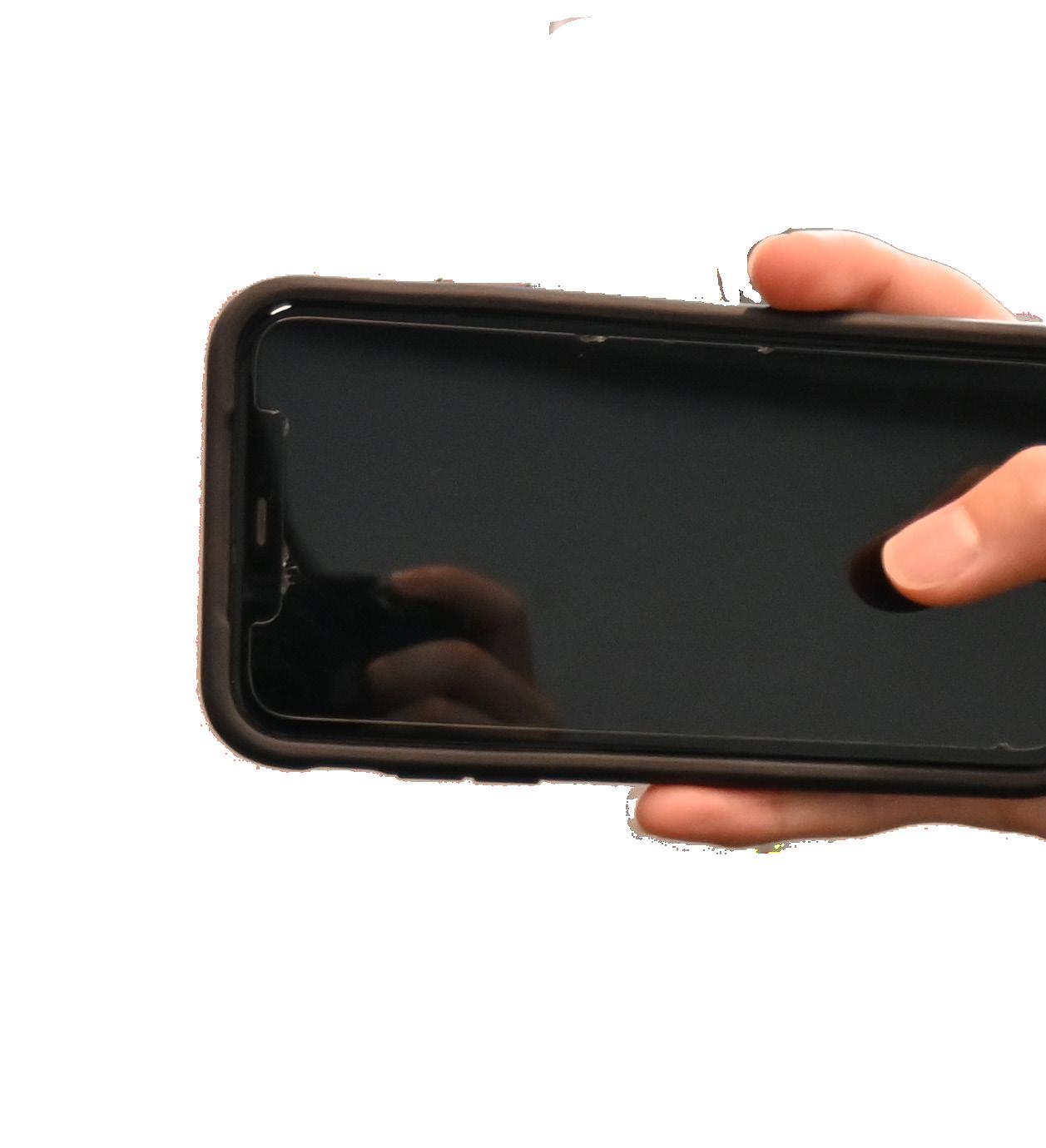

At the height of the pandemic, phone were relaxed due to distance and hybrid learn ing as well as communication difficulties plexiglass in the cafeteria.
The fall policy aims to return to what school environment was like before the demic. “Since I’ve been here the last two we’ve said no phones in the classrooms and Huss, and really left it up to teachers if a student was being disruptive on their phone in a space,” Dean of Students Stacy Tepp said.
The addition of the cafeteria as a completely phone-free space returned the cafeteria phone rules to what they were before the pandemic. decision to make the library phone-free this tried to honor the atmosphere of the library making it a quiet study space. “It’s more about as we continue to learn more about how phones impact our brains and how we communicate with each other, what kind of environment want to set up for students,” Tepp said.
ban on phone usage in school
GRACE MEDRANO THE RUBICON

banned phone usage during school hours. Minnesota, on the other hand, has passed legislation that requires schools to create policies around students and phone usage in the classroom.
History teacher Aaron Shulow said “I think the way a policy is characterized is important, and so I would not call it a ban or a prohibition, because I think it gives the impression that this is a punishment. To my knowledge, this is not a punishment.”
Concerns about the usage of screens in the classroom aren’t anything new, and the impacts have been noticeable. According to the Pew Research Center, 72% of high school teachers in the U.S. reported their students being distracted by cell phones during class, and 58% reported that their students show little to no interest in learning. This came soon after research back in 2017 that already expressed concerns over the usage of computers in the classroom.
Shulow expressed
his concerns, “a bunch of us teachers went to a conference in April, and all these psychologists and neuroscientists were all talking about how if we’re here at school, and the smartphone isn’t adding anything unique, it shouldn’t be used.”
“
IF YOU’RE TRYING TO SET UP ESTABLISHED RULES AND HABITS ... BUT THERE ARE ALSO PEOPLE IT WON’T WORK FOR.
senior
Madeline Kim

whilst on campus. Florida and Louisiana have both already put the policies into action, and South Carolina plans to begin enforcing its new policy with the arrival of 2025.
Along with Minnesota, Indiana, Ohio, and Virginia have also implemented plans to minimize phone use during academic time, with exceptions relating to health conditions, IEPs (Individualized Education Programs) and 504 plans, refering to accommodations for physical or mental impairments in public schools.
Shulow agreed with Minnesota’s actions. “I think one main exception is that a phone can be a critical device to monitor critical health measurements of what the body is experiencing, and what it needs. And even for journalism, lugging around equipment can be burdensome, so you put the press pass on and you do your official business.”
school districts but do not require it.
“I think it could be beneficial to different students depending on their relationship with technology, and if you’re trying to set up established rules and habits, it could help with that. But there are also people it won’t work for,” senior Madeline Kim said.

“
IT’S MORE ABOUT ... WHAT KIND OF ENVIRONMENT WE WANT TO SET UP FOR STUDENTS.
Dean of Students
There are states that haven’t taken firm action, with Washington, Alabama, and Connecticut having “recommended” policies that encourage the creation of phone rules across rooms. Acthem, Jonathan bestseller list schools back hallways and removing rules learndifficulties with what the panyears, and in student space,” completely phone pandemic. The this year library by about phones communicate environment we
These are the issues that schools all across the country, not just SPA, are dealing with. While concrete actions have not been taken on a federal level, state governments have begun implementing their own policies and legislations.
“I’m hesitant to speak for other people, but there’s a fairly broad consensus that this is good. I think it will be better for all of us,” Shulow said.
Phones have become an essential part of day-to-day life, so now schools have to deal with what that means, and what actions to take. It seems there is no “right” answer to be found, as states each develop their own policies, but the collective agreement seems to be that phone usage in schools must change.

Research on mental health effects has been part of the discussion: “There is a lot of research that’s been done about phones and how phone use has had such a detrimental effect on students’ mental health and well-being,” Stading said. “It’s considered a public health crisis.”
After the Mind, Brain, and Education conference, Stading and the other attendees discussed their thoughts with the other faculty and administrators. They talked about how to create a human-centered community. “Just about every single talk focused on how important human skills are … not just for workplace success but more importantly for your health, happiness, and well-being,” Stading said.
Sophomore Eva Johnson is concerned about the impact of the no-phone policy pilot in November.
“[It] makes it hard to let my parents know what I am planning to do after school and difficult to quickly check my schedule,” she said. “I think it is a good idea in theory, but I’m worried I’m going to accidentally take my phone out because of habit and then have it taken away.”
Senior Caden Burns supports having the current phone-free zones, however, he has concerns about completely eliminating phone usage in November. “The transition at the beginning of the year was already difficult, and I’m wondering if we could handle something much more aggressive than that all at once,” he said.
Similarly, sophomore Mattias Halloran supports the idea but not how it was put into action. “I understand the shift away, but I felt the initial execution was poorly handled,” he said.
Ways to improve the policy have been discussed and proposed. “I don’t really want us to move towards
those phone lock boxes or pouches. As we become adults we should focus on building responsibility and maturity, learning to resist the temptation of constantly needing our devices…we should be working towards something [that will help outside] the eight-hour school day,” Halloran said.
The phone usage policy will continue to be tweaked as students and faculty examine how it goes this year.
For now, SPA is going back to preCOVID - a return back to history.


LIES:
JUAN MIGUEL ADAMS
MANAGING EDITOR
Freely offering to do something, volunteering is a commitment to helping others. From local churches to non-profit organizations, junior Nijah Johnson and senior P.J. Bohjanen have stepped up to make a difference in their communities.
In 2018, Bohjanen saw an advertisement for community service at his local church, The Grove United Methodist Church in Woodbury, MN. Bohjanen’s work at The Grove UMC aims to create a supportive network within the community of the Church and Woodbury. Bohjanen has packed food and hygiene kits for the homeless, collected canned food for food shelters, and built wheelchair ramps for families in need.

SUBMITTED PHOTO: Nijah Johnson
“I’m not a very social person, … so it’s kind of hard for me to talk to people but I develop social skills talking with families,” Johnson said.
Similarly. Bohjanen has had positive exposures in his volunteer work, “Since I go to school in St. Paul, I don’t get to meet as many people in Woodbury. [Volunteering] is my way of feeling integrated and connected to my community,” Bohjanen said.
Johnson volunteers in community get-togethers. On Aug. 25, she helped with a cookout in Minneapolis set up by Urban League. “Even though it was a cookout everyone got up and started dancing the Tamia shuffle, it was nice,” Johnson said. “It had food but the dancing and energy made it so special.”
senior P.J. Bohjanen “
[VOLUNTEERING] IS MY WAY OF FEELING INTEGRATED AND CONNECTED TO MY COMMUNITY.

“I feel good about doing it. It’s a great thing to do ... giving back to your community and helping out,” Bohjanen said. He emailed to get involved and continues to volunteer today.
Since 2021, Johnson has been actively involved in community events aimed at celebrating and promot-
DRIVING DRONES. Johnson leads an activity at her volunteer job, flying drones with children. “Volunteer for the things you care about; I care about my community and helping,” Johnson said.
ing family values and healthy communities. Johnson volunteers for the non-profit organization Urban League, which provides events, employment, and educational opportunities for people of African descent and advocates for issues affecting their community. These events range from back-to-school sessions where she assists barbers in cutting students’ hair to workshops that teach the local community about piloting drones.
“I heard about the community volunteering from my aunty, and I liked helping people so I joined,” Johnson said.
Johnson has faced challenges in their volunteer work, but it has allowed them to develop new skills.
During the pandemic, part of Bohjanen’s volunteer work at The Grove UMC involved writing letters to people at risk who needed to stay isolated. “One of my most memorable moments was when I wrote letters basically saying, ‘hey, we’re thinking about you’ and I got a really sweet letter back thanking me and it was a nice moment,” he said.
Bohjanen recommends volunteering to anyone hoping to get involved, “I would say do it [volunteering], only a good thing can come from doing community service,” Bohjanen said.
Similarly, Johnson advises people to follow their passion in volunteering, “Volunteer for things you care about; I care about my community and helping, so I volunteer to help people.” Johnson said, “But volunteer for whatever you like.”

IVY EVANS THE RUBICON
‘Why join a club when I can have a free period instead?’ ‘I’m too busy for extracurriculars!’ ‘What if I don’t know anyone there?’ Are sentiments expressed by students plenty of times before. But many people may be overlooking the importance of extracurriculars. St. Paul Academy and Summit School offers a variety of clubs, sports, and other activities including Summit Singers, the tennis teams, and Book Club. Students across grade levels participate, but the reason these activities continue to run is because more and more underclassmen are joining and helping the groups grow.
Sophomore Tallulah Dogwill joined SPA’s volleyball team for her first year this fall. After struggling with some issues related to breathing, she wanted to join a sport that didn’t involve much running and decided that volleyball was her best option. She’s been enjoying the opportunity to learn a new skill and interact with team members and coaches: “I was a little nervous doing it for the first time as a sophomore, but so far, the team has been super nice and … really supportive,” Dogwill said.
Sports aren’t for everyone, but that’s not a setback for freshman Oakley Schonwald, a new student at SPA. Schonwald is interested in joining a wide variety of affinity groups and activities: shey hope to be involved in the fall play, as well as the neurodivergent, queer, and Jewish affinity groups. “From what I’ve heard, … it seems like a great way to make friends, especially if you’re joining an interest based group,” shey said. “No one’s going to judge you for having that interest, because that’s why you’re going to said group.”
I WAS A LITTLE NERVOUS DOING IT FOR THE FIRST TIME AS A SOPHOMORE, BUT SO FAR THE TEAM HAS BEEN SUPER NICE.
sophomore Tallulah Dogwill

Freshman Teddy Crook, also new to SPA this year, hopes to find his place within both areas of extracurriculars: theater and sports. They are planning to join the Alpine skiing team during the winter, as well as the fall play. “I’ve been … skiing for a while, and I’ve


done a few years of ski racing. … I wanted to continue that here,” he said.
Some might say extracurriculars can be frivolous, but the participants find them valuable. “I do think it’s really important, because it kind of helps you build opportunities and gives you a sense of belonging outside of just the classroom,” Dogwill said.
Students have different opinions about the importance of extracurriculars, though. “I just feel like it’d be kind of boring without … any activities or … sports to do,” Crook said.
Some underclassmen have expressed doubt or uncertainty about joining new clubs or extracurriculars, but there are plenty who believe that the groups are beneficial to students.
“It can get easy to get wrapped up in the whole idea of ‘I need to focus on school and get good grades.’ That’s all important, but you can … forget to … enjoy the not-school part of school. … I think clubs are a great way to [avoid] that,” Schonwald said.
Even with some uncertainty around joining, many voices from across the school are willing to encourage others to join clubs. Dogwill offers her advice to students who are debating whether or not to join a new activity: “Just go for it.”
ANNIKA KIM THE RUBICON
With the upcoming 2024 elections, junior William Hanna knew they had to involve themselves in politics over the summer break. From the third week of June to the second week of August, Hanna interned for the campaign of Betty McCollum, the congressional representative for Minnesota’s fourth district.
The task at hand for the summer focused on using the McCollum campaign’s resources to attach her name to local Democratic candidates.
“She wins by like 70% of the vote every single time, and so the biggest concern was not getting Betty elected, because that’s kind of a given in Minnesota politics,” Hanna said.
IT WAS REALLY FUN TO HAVE A GROUP OF PEOPLE THAT WERE AS ENGAGED AS I AM, TO VOLUNTEER WITH THEM.
junior William Hanna

typical campaigning activities such as marching in parades and knocking on doors, but the internship also allowed Hanna to be able to experience the process on a personal level, such as meeting McCollum herself.
“We got to have lunch with her at a restaurant and just chat about stuff,” they said. “It was just really awesome to just be able to ask her about stuff, and talk to her because she’s so smart and so experienced, and hear how she thinks about things.”
The internship came with other educational opportunities due to the fact that it was part of a nationwide internship program, one of which was the ability to connect with like-minded people interested in politics in and outside of the state.
“It was really fun to have a group of people that were as engaged as I am, and to be able to volunteer with them,” Hanna said. “We had a group chat, and so we would all be out door-knocking at the same time… and every time one of us had a funny interaction, we just sent off a text, and then we’d all like, look at it and laugh.”
Hanna encourages students interested in politics to consider participating in an internship, citing how important the help of volunteers is in campaigns. “It can seem scary to get involved in politics, but you can make a big difference,” they said.

ZHANG EDITOR IN CHIEF
As the fall season unfolds, a number of players show immense promise among their team in representing SPA in their games, matches, or meets. Here are the athletes making headlines and worth keeping an extra eye out for.
Senior Olympia Wolff serves on the Girls’ Varsity Volleyball team with the positivity she brings and inspires other players. As points and rallies go back and forth on the court, a weak mentality may result in athletes facing challenges. But this isn’t the case for Wolff: “I can easily shake off things and focus on the next point, and I’m not often sad about losses,” she said. “I feel so lucky to play with the SPA girls, and it’s important to help others feel the same.” In addition, according to Wolff, her six feet, three inches stature intimidates opposing teams, resulting in hitters not swinging as hard or tipping the ball versus going for the kill. The girls’ varsity volleyball team will have their next game against Providence Academy Sept. 25 at 7:00 P.M. at home.

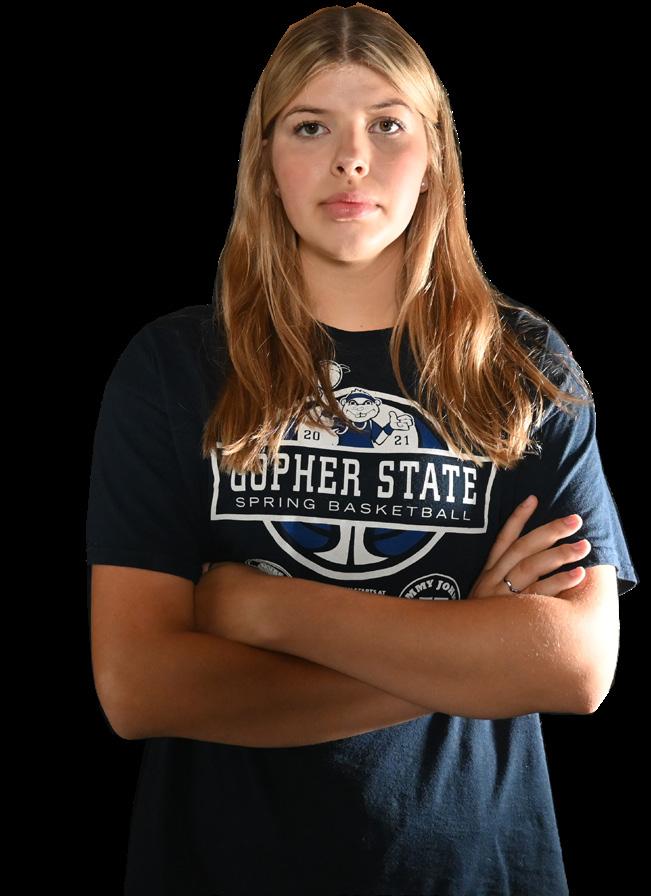
Junior Nellie Larson commands the tennis court in first singles with her consistency and endurance. Contrary to popular belief that tennis players do not run as much due to the court’s size, Larson debunks this myth with her extended rallies while keeping a positive attitude during tough times. Her stamina and ability to dominate the court was on full display while playing at a tennis tournament for charity: “I’m proud of playing in a tournament to raise money for children’s cancer and raising $5000,” Larson said. The Girls’ Varsity Tennis team will have their next match Sept. 25 at home at 4:30 P.M. against Burnsville.
Junior Cutler Crook shines on the SMB Wolfpack Football team offensive line as right tackle or guard. In his words, the position best suits his size and speed and takes after previous family members who played the same role. “He stops the other team from instantly running to the quarterback,” junior teammate Otto Rudolf said. In particular, Crook looks up to his grandpa for his accomplished football career, including starting on his college team and winning a divisional title, as well as being a kind and knowledgeable figure towards his grandson. The SMB Wolfpack Football team will have their next game at 6:00 P.M Sept. 27 against BenildeSt. Margaret’s at The Blake School.





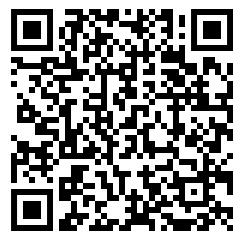

Freshman Graham Waibel is an upcoming standout and earned a spot on the boys’ varsity soccer team after impressing coaches with his technical abilities on the ball. Having played a number of positions in all parts of the field, his current role consists of attacking as a winger or an attacking center mid. Waibel’s ball handling and control has allowed him to take on older players with ease and send crosses into the 18-yard box for his teammates to shoot, racking up an assist to freshman Max George against Highland Park Aug. 23. “In a couple of years, he’ll be one of the best players in the state,” captain and teammate Arlo Zirps said. The boys’ varsity soccer team will have their next game against Minnehaha Academy at Minnehaha Academy Sept. 24 at 5:00 P.M.


Senior and captain Adele Gjerde has been swimming with the Sparks Swim and Dive team since her sophomore year and earned the team 423.52 points during the 2023-2024 season. Gjerde swims a number of events for Sparks including the 100 yard freestyle, 200 yard freestyle, and 100 yard backstroke. These events allow her to maintain pace while still testing her stamina. In the water, her endurance and speed are matched only by her support for teammates. “I’m really loud in the pool, so during practice, I’m outgoing, supportive, and motivated,” she said. The Sparks Swim and Dive team will have their next meet Sept. 25 against St. Paul Central at St. Paul Humboldt High School.
Senior Taylor Barkwell, co-captain of the cross country team, has been capturing the spotlight since seventh grade, improving her times every season in the 5000 meter event. Barkwell’s greatest strength lies in a tough mindset, as can be seen in her 19:47.9 personal record that she earned in the 2021 season, as well as her 20:05.2 season record from the 2023 fall season, landing her sixth place at the section championship. “I think my greatest strength in running is probably my mental game– being able to work through the pain and push myself way past my mental limits,” Barkwell said. The cross country team will have their next invitational at 4:20 P.M at Levi P. Dodge Middle School Sept. 26.

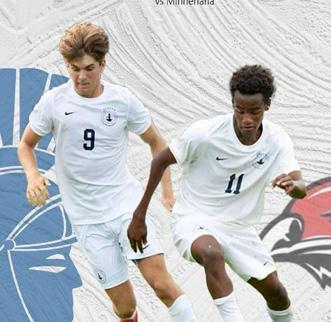



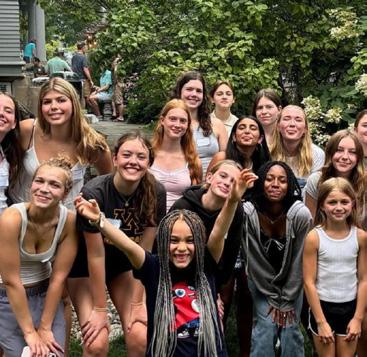

LINA ABID THE RUBICON
Aileen and Rycke Guiney were involved in soccer long before they became co-coaches of the girls’ varsity soccer team.
“Soccer is both of our favorite sports. Our dad coached us growing up, separately because of our age difference,” coach Aileen said.
The pair both had coaching jobs during college, and seized the opportunity to return to it and work together.
For the first time in a while Rycke and Guiney were living together, and decided to coach together.
“It works because, you know, philosophically we’re aligned, right? Like, we came from the same place as players,” Coach Aileen said, “It’s about a competitive environment, but culture first.”
Sophomore Sofia Johnson feels this reflected in their practices, “They like
to make it comfortable and push us to be our best selves every day,” she said. Not only do their coaching philosophies coincide, their personalities work together. “We’re really different people,” coach Aileen said.
IT MAKES IT FEEL MORE OF A SAFE SPACE WITH THEM BEING SISTERS. “
sophomore Sofia Johnson

“Any team, you benefit when you have people that, you know, bring diverse experiences and different personalities. And so I wouldn’t want us to be the same. It’s good that we’re different, and I think the kids benefit from it,” she said.
There’s also a necessary respect between the two, not just as sisters but as soccer coaches. “I got to watch her, and I got to see her as a soccer player, and so just like the respect I had of my coaches, I have the respect of her,” said coach Rycke.
Their sibling relationship allows them to develop their coaching through their comfort in one another.
“They’re so comfortable with each other that they also do hold each other to a high standard for coaching as well, like on the sidelines at games and stuff, they bounce ideas off of each other,” Johnson said.
Coaches Aileen and Rycke hadn’t gotten to work together before coaching together at SPA, and with a 10 year age difference and after time spent living in separate states, they were excited by the opportunity. The two foster a supportive environment.
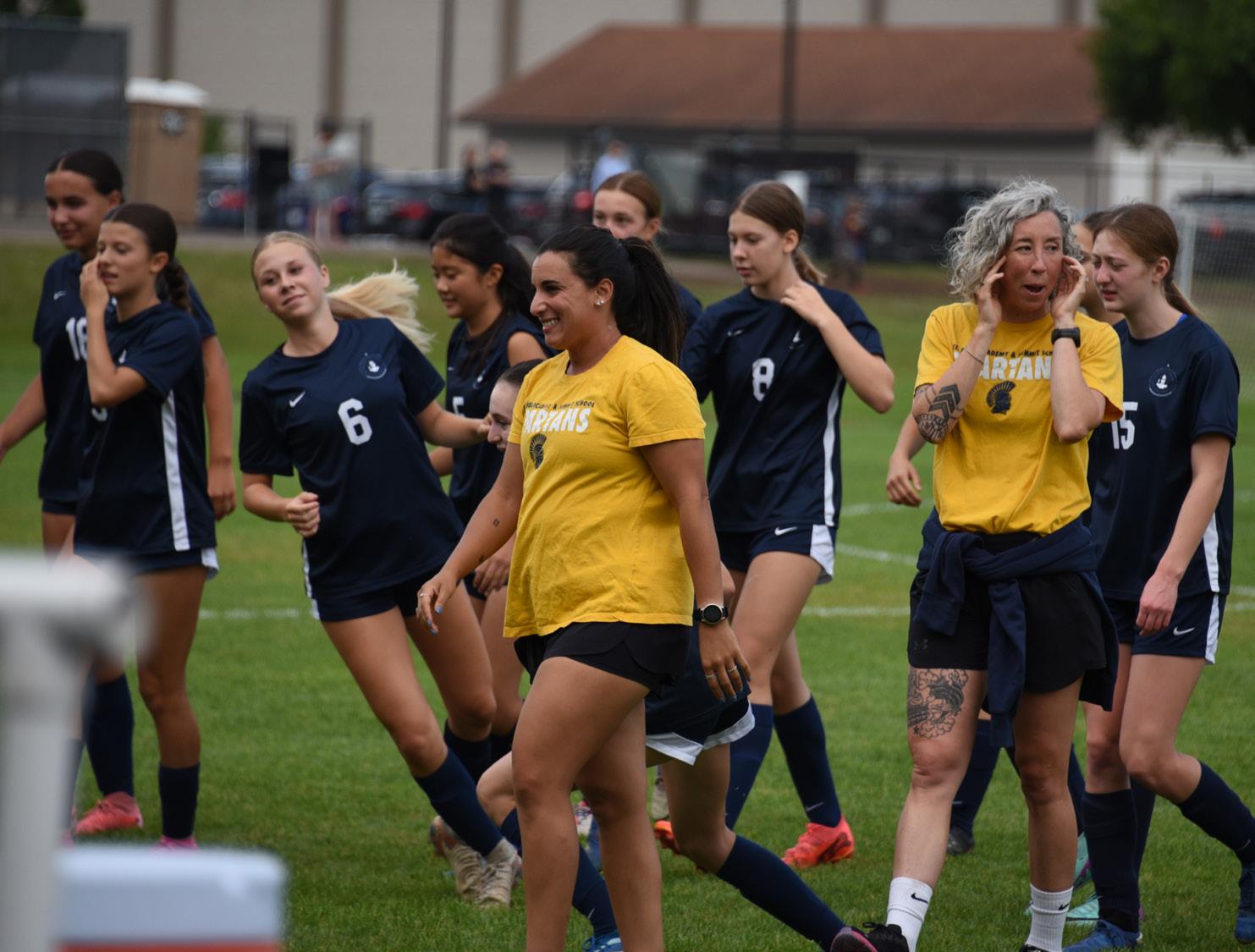
“Them being sisters makes the team have a really fun dynamic.” Sampsell-Jones said.
Following up, Johnson similarly commented “it makes it feel like more of a safe space with them being sisters. ... I think that also makes for a fun and silly environment.”
Aileen and Rycke coaching together provides a way to spend time with one another and allows them to connect to their soccer past. “We’re here for the fun,” Coach Aileen said. “We love hanging out, so it’s a no brainer. Like, we get to be doing our favorite thing, outside, with each other.”

Not new to SPA, MS science teacher Stacy Overgaard serves as the new head coach of boy’s Swimming and Diving and assistant coach of girl’s Swimming and Diving. This year, Overgaard returns to coaching both teams, having previously coached from 2001 to 2008. “My philosophy is ‘anyone can contribute to the team’, regardless of how fast you start out,” she said.

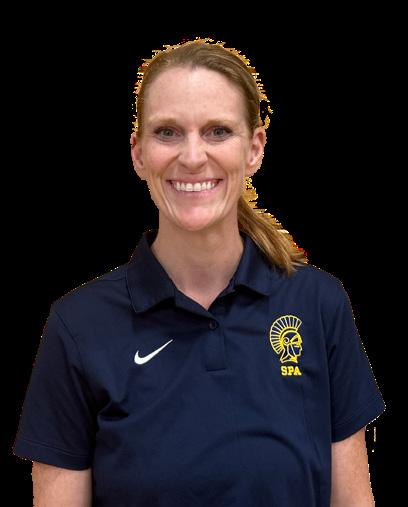
Leslie Blakely is the new volleyball coach. Her experience includes coaching both high school and club for 10 years. Blakely finds her favorite aspect of coaching to be encouraging her athletes to be the best they can. “As a woman, I find it very important for girls to participate in sports and have a coach who is there to mentor and support them,” she said.

Logan DuFord, a new coach for girl’s soccer, brings her connections with soccer to the SPA field. Before coaching, DuFord played on several collegiate teams, citing the varied experience as a major contribution to her approach to coaching. “The opportunity to make a positive impact on their journey and witness their progress is what I cherish most about coaching,” she said.
Cross-country pushes boundries at Metro invitational
course disrupted the runners’ set pace. The new terrain also encouraged them to alter their pace as they knew speeding up or slowing down could mean the difference between victory and disappointment.
Sept. 14 and 15 was filled with dreary weather and intense competition, SPA’s cross-country team tackled the fastpaced races of the annual Metro Invitational in Eden Prairie.
The Metro Invitational differs from most other cross-country meets that
SPA participates in; rather than taking place in the forest, the race is held on a flat field, and instead of running one long loop, athletes run three laps of the course. The flat, grassy course seemed deceptively simple compared to the rugged forest trails the team was used to. Without hills or turns to rely on for rhythm, the
From warm-ups to the final kick across the finish line, SPA’s athletes and coaches were ready to compete– all of the girls’ varsity team participated in the women’s 5000 meter, and all of the boys’ team participated in the men’s 5000 meter.
Sophomore Paloma Good participated in the women’s 5,000 meter race at this invitational. Last year, Good earned
All-Conference Honorable Mention as a freshman. She is one of five people on the team who made All-Conference or earned an honorable mention.
The meet kicked off at 9 p.m.; the SPA team arrived well in advance, mentally preparing for the race with stretching, dynamic warm-ups, and focused conversation.
For those not involved in the sport, running long distances while saving energy to maintain an even pace may sound daunting. However, it is a bit simpler than one might think. “I usually just focus on my breathing,” Good said.
History teacher
Ben Bollinger Danielson, is the head coach of the boys’ and girls’ cross-country team. “This meet, like every meet, it’s a chance for athletes to continue to sort out their relationships with competition; [they should] race and see how they’re improving,” Danielson said.
This approach as a coach allows first time athletes to the sport to compete and experience competition which will develop their understanding of the sport and help them blossom as athletes and a student of the game as they progress through their high school careers.
The girls’ varsity team placed 17th out of 23 schools, with some standout performances: Taylor Barkwell placed 51st with a time of 20:18 and Paloma Good placed 81st with a time of 21:16. The boys’ varsity team placed 24th out of the 24 teams, with Finn Miller-Fimpel placing 179th with a time of 19:50.
read more about crosscountry at the: RUBICON online

- SEPTEMBER 2024
ANNIE ZHANG EDITOR IN CHIEF
As the trend of cycles recircle back to the 90s, Gen Z’s new favorite gadget offers a nostalgic charm and unique aesthetic reminiscent of a period of time where being a “screenager” wasn’t a part of ev eryday life. The revival of the digital camera has proved that sometimes, even old is new again.
Following the initial discovery, the invention of the digital camera soon skyrocketed into markets with the Dycam Model 1, the first consumer model, being released in 1990 with improvements such as internal memory components and LCD screens soon trailing after. While the release of the smart phone’s sense of effortlessness in everyday photography quickly outweighed the use of the digital camera, the retro feeling the digital camera offers is a feat that the modernity of the camera app can not replicate.
“I prefer the aesthetic and look of the digital camera. I think photos taken on digital cameras can be more meaningful because it usually isn’t the default,” senior Scarlett Gibson said.
In addition to the old-timey look, digital cameras also provide a break from screens and give an impression of authenticity on social media. The hashtag “digitalcamera” on Tiktok has even racked up a total of 203.4k posts under it and users have reported difficulties in purchasing certain models online as a result.

This spike of popularity has inspired many to see the value of owning a digital camera: “I used to go to camp without a phone and I only knew [few] people with digital cameras …” sophomore Avi Coleman said. “But ever since it has become more trendy to have a digital camera, almost everyone has one.”
Despite the digital camera’s resurgence among Gen Z, new innovations began to drop off by the mid 2000s, as smartphones offered a more compact and convenientphotography experience. For junior Thomas Ferguson who recently acquired the original version of the Black Magic Pocket Cinema, his biggest problem has been with the battery life.
“It’s kind of difficult to work with because the battery dies in 10 minutes and it’s not great. I want to get a new one but they’re very expensive,” he said.
Regardless, in comparison to a smartphone camera, Ferguson still prefers to use a digital camera for its quality and has a work-around, stating that he keeps a battery pack on deck at all times.
Although the comeback of digital cameras among Gen Z began as a trend, these retro devices elicit a feeling of nostalgia within the grainy finish and orange timestamp on every photo that the modernity of a smartphone is unable to capture. Beyond the vintage allure, the refreshing break from phone screens and versatility digital cameras provide ensure that this trend is likely to stick around for the foreseeable future.


PIERACH
The declaration was inescapable: movies are back. Well... last summer, that is. Following pandemic closures and low enthusiasm, it seemed that cinema was having its moment again as Barbenheimer dominated the box office and the awards season and fans flocked to the theater dressed in the iconic shade of pink. So when the weather began to warm up, the bar for the summer movie season seemed arbitrarily high. Did this year’s flicks live up to their massively-celebrated predecessors? Sort of. Here are the winners and losers of the past few months at the theater.
The summer movie season started off as a slog, with Memorial Day weekend seeing the lowest box office numbers in almost 30 years. The top flicks were Furiosa: A Mad Max Saga and The Garfield Movie, bringing in $32 and $31.1 million, respectively. With the exception of 2020 pandemic closures, Furiosa was the lowest-grossing Memorial Day leader since 1995’s Casper
On June 14, a successful season of cinema seemed back in play with the release of Inside Out 2. The film brought in almost $652 million domestically and $1.6
billion worldwide, making it the highest-grossing animated film of all time along with the eighth-biggest overall. The sequel to the 2015 Pixar hit, which follows pre-teen Riley at hockey camp and her relationship to anxiety, earned a 91% score on Rotten Tomatoes with warm audience and critical reception.
In general, sequels and franchise installments made the biggest splash, as evidenced by movies such
SUMMER ‘23 vs SUMMER ‘24
SUMMER 2023 TOTAL BOX OFFICE EARNINGS: $4.09 Billion
as Despicable Me 4, Twisters, and Bad Boys: Ride or Die
One notable exception is the serial killer creeper Longlegs, the year’s highest-grossing independent movie at $100 million. Longlegs also stood out as an anomaly in a genre of underperformers, including The First Omen ($20m), Immaculate ($23m), and The Watchers ($19m).
Summer 2024 saw two massive hits between Hollywood royalty Blake Lively and Ryan Reynolds, covering two vastly different genres and likely audiences. Deadpool & Wolverine, starring Reynolds and his close friend Hugh Jackman, entered theaters on July 26 and has become the biggest R-rated movie of all time. So far, the superhero blockbuster has grossed $614 million domestically and $1.2 billion worldwide, making it the second highest-earning film of the year.
It Ends With Us, an adaptation of Colleen Hoover’s massively popular 2016 novel, also saw success in its own right. The $25m-budgeted Sony film hit theaters on Aug. 9 and has so far brought in $309 million. The movie centers around a young woman named Lily Bloom, who falls for a charismatic neurosurgeon and finds herself in an abusive relationship. The film received mixed reviews on its handling of the topic.
With big names and numbers, the summer movie season was one of record-breaking highs and lows. Cinema appears to have held its ground, at least through August.

“Art is for everybody.”
This is the personal slogan of pop graffiti artist Keith Haring– well known for his stylized works characterized by bold, cartoonish figures, objects, and strokes that lay the foundation for many of his works and projects.
Wanting a larger audience to access his art, Haring started creating his works with chalk on empty poster boards in the New York City subway. Even after acclaiming fame, he still preached that people anywhere should be able to see his art, creating over 50 public murals containing social critiques.
After his AIDS diagnosis in 1988, Haring established The Keith Haring Foundation, an organization to destigmatize, research and spread awareness about the disease.
The Keith Haring: Art is for Everybody exhibition at the Walker Art Center in Minneapolis opened from Apr. 27 until Sept. 8.

Assembled by Sarah Loyer, the curator of The Broad Museum in Los Angeles, the Walker’s exhibition follows Haring’s ten-year career. Haring also has two other current exhibitions at The Stanley Museum of Art
in Iowa City, Iowa, and at the Nakamura Keith Haring exhibition in Yamanashi, Japan.
The Walker’s exhibition spans three floors and contains around 40 works, ranging from artwork on objects, indus -
trial tarps, canvas, paper, pottery and clothing. The exhibit includes many videos and photographs highlighting Haring’s animations and public works.
Chronologically following his career, each
room explores a chapter of his life, delving into the more profound inspirations and events his work was based on.
Visual intrigue was kept in mind throughout the gallery, each room dedicating at least one wall to add a splash of color or sprawling pattern. In particular, near the middle of the walkthrough, the room housing Haring’s Day-Glo works from his 1982 Shafrazi Gallery was painted with pink and orange stripes and rigged with ultraviolet lighting to complement the fluorescents used.
Some of Haring’s most profound work is stationed near the exhibit’s end, prominently illustrating his views and activism on politics, capitalism, sexuality and religion. While many of his pieces throughout his career hold a lot of messaging, these later paintings focus on more specific issues and more explicitly express his views.
The final section of the Gallery delves into Haring’s battle with AIDS
and the legacy he wished to leave behind. The exhibition incorporated Haring’s quotes: “Amazing how many things one can produce if you’ve lived long enough. I mean, I’ve barely created 10 years of serious work. Imagine 50 years…I would love to live to be 50 years old. Imagine…hardly seems possible.” Alongside this quote was a work titled Unfinished Painting. The piece is composed of purple paint with Haring’s signature bold patterns in the top left corner that slowly fade out, dripping down until only a blank canvas remains.
Keith Haring: Art is for Everybody leads visitors on an extraordinary journey, highlighting Haring’s short but passionate career. Portraying him accurately to the best of their abilities, they don’t shy away from pointing out his faults regarding cultural exotification and appropriation. Audiences will leave with a beautiful visual experience and a new understanding of what drove Haring’s life and work.

GAVIN LEUTHOLD THE RUBICON
Lights. Applause. Big crowds. The attendance at the Minnesota State Fair this year broke daily records from the 2023 year. According to the Minnesota State Fair website, five separate days in 2024 set new daily records for attendance. The State Fair’s many performances and concerts drew crowds of people to the fair. The fair saw performances from rapper and singer-songwriter Chance The Rapper, rappers Ludacris and T-Pain, and Kidz Bop, a children’s music group, among many others.
One particular event at the State Fair saw an SPA student, junior Atari Ernst, performing
himself. He danced with the Cypher Side Dance School at the Minnesota State Fair Amateur Talent Contest Finals contest on Sept. 1. “My favorite part of performing at the State Fair was the environment and getting to perform at the Grandstand ... It’s such a cool experience,” Ernst said.
Comedy shows made up part of the many performances at the fair this year. Junior Hazel McCarthy went to Nate Bargatze’s comedy show on Aug. 24. Nate Bargartze is an American comedian who does stand-up and is also famous for his SNL sketches. Much of his humor revoles around everyday life, and parenting.“He does stand up and he makes a lot of riffs
about certain situations,” she said.
The show was outside at night and had lots of attention-grabbing lighting. “My favorite moment was when it got dark out, since it was outside and it had a lot of lights up,” McCarthy said. “It was really cool to see all the people laughing with all the lights up.”
While McCarthy saw a comedy show, sophomore Caden Deardurff attended a concert by a group called Kazual (pronounced Casual). Kazual is a family band consisting of three brothers and a cousin. “They do a mix of acapella-like singing combined with coordinated dances,” Deardurff said. “It was a fun with everyone getting engaged,
and the music they sang ranged from 80’s hits all the way to Bruno Mars.”
Deardurff enjoyed the concert and he noticed that others did as well.
“My favorite part was when a grandma and her two young granddaughters, probably 4 or 5, got up to dance in the little open area in front of the stage,” he said.
Many people enjoyed concerts at the Minnesota State Fair because of the enthusiastic energy and the outdoor experience. Deardurff enjoyed a music and dance concert, McCarthy was amused at a comedy show, and Ernst perfomed with his dance school. The next State Fair in 2025 will bring a plenitude of new and returning performers.

QUESTION 1
You walk into the kitchen and see one ingredient: chocolate. If tasked to make a dish, which dessert would you prefer making?
A. My gut immediately tells me to make a chocolate cake. Playing with the oven and decorating a cake with fun frosting designs and sprinkles always brings me joy.
B. I am terrified of using the oven and will be sticking with a delicious chocolate ice cream, which only really requires a mixing bowl and a freezer.
QUESTION 2
When seasoning a dish, do you carefully measure out each condiment and spice or do you just go all in?

A. Measuring spoons are at my constant beck and call; I never start making a dish without them.
B. Eyeball it; I go with my instincts and add however

QUESTION 3
You are hosting a party and are scrambling to come up with a dish. Do you choose to make a charcuterie board or a big, hearty bowl of pasta salad?
A. Charcuterie board; I would never let a crowd down, I always go above and beyond; presentation matters.
B. Pasta salad; I can fill it with my favorite type of pasta, vegetables, deli meats and condiments. Plus, it only takes 10 minutes.
QUESTION 4
You are asked to carefully follow a recipe for a dish; do you follow through?
A. Obviously; I will be carefully reading to ensure I make a great dish and will hardly stray away from the recipe.
B. Not fully; I will add some personal touches and will not be using measuring tools. The recipe says to only add a pinch of pepper? Best believe I will be seasoning my heart out.
QUESTION 5
You have the job of decorating a cake for your friend’s birthday; how will you decorate it?

A. I will be using tons of frosting with twenty piping techniques and a masterpiece full of sprinkles and maraschino cherries; the cake will be full-on spectacular.
B. Simplicity is my best friend; I am not aware of many decoration techniques, but I will do a simple frosting piping design and pull out a handful of sprinkles.
You picked more A’s than B’s:
You picked more A’s
SPA just gained another baker! You are very meticulous and follow directions to the best of your ability, but are also very creative, adding toppings to your baked goods. You are not intimidated by the oven and often prefer using one over a stove.
Another chef has entered the SPA community! You are not a fan of directions and often create your own spins to a dish. You believe in working smarter, not harder and take the simpler paths in life that bring you joy.
HSIUNG CONTRIBUTOR
Outside of the myriad of schoolwork and extracurricular activities shared by students and faculty alike, experimenting and creating in the kitchen is a beloved activity, whether hobby or routine.
English teacher Akie Kutsunai cooks every day, finding joy in meal prepping when they are busy during the week and often sticking to simpler dishes, like salads Monday through Friday.
When they have more time to cook over the weekend, Kutsunai is “experimenting more with things like how to cook potatoes, or how to cook pasta, ... which are less familiar to me.”
On the other hand, senior Nicholas McCarthy has been cooking since before he could remember, though cooking has become more of an intermittent activity for him over the years. Nowadays, McCarthy spends time in the kitchen about once a week and plays with recipes in some of his mom’s cookbooks. His new favorite dish? Pasta cooked in alfredo sauce and topped off with salmon.
become well versed in various baked goods and dishes.
Brenneman’s baking ideas stem from other forms of media, namely baking shows and recipe books. “I’d watch The Great British Baking Show, for example, and some of the things that I saw there, I’d try to find the recipes for and make them. I was also gifted recipe books for multiple occasions, baking books, and so I looked through those and picked some things to do,” he said.
THINK ABOUT WHAT YOU ALREADY LIKE TO EAT ... THEN THINK ABOUT WHAT YOU COULD MAKE FROM THIS.
English teacher Akie Kutsunai
Like McCarthy, sophomore Aldegundo Brenneman cooks from time to time, but he prefers baking, starting with breakfast foods six years ago. From making eggs, pancakes and waffles to later transitioning to cookies, scones, Swiss rolls and cakes, Brenneman has

Though cooking and baking may seem like difficult and intimidating activities to pursue, there are a number of ways to get started. In particular, technology is a prominent source to find recipes and gain inspiration.
Kutsunai browses The New York Times cooking channel on YouTube, often watching American chef and restaurateur Sohla El-Waylly’s videos where she showcases a unique ingredient by using it to make a meal. With time and practice, personal instincts and desires can help leverage the experimentation stage of cooking and baking.
“Think about what you already like to eat,” Kutsunai said, “so if you go out and have a nice splurge for yourself ... have it and enjoy it and then think about what you could make from this ... because that gives you something to start with.”

Breakfast is often regarded as the most important meal of the day. The Griffin omelet has plenty of protein to keep the body fueled for the day. Commit some time to this omelet, and end up with a pan full of golden-brown, fluffy egg bake to start off the day.
First, set your oven to 325 degrees fahrenheit. This omelet requires eight eggs, ½ cup of mayonnaise, ½ cup of milk, ½ teaspoon of dill weed, ¼ cup of grated parmesan cheese, and three tablespoons of butter. Start by cracking the eight eggs into a large bowl. In a liquid measuring cup, or a separate bowl, measure out the ½ cup milk, and add the ½ cup mayonnaise to the milk. Add the milk-mayonnaise mixture to the large bowl of eggs. Add ¼ cup of parmesan to the large
bowl as well. (Add extra cheese to your liking). Add ½ teaspoon dill weed, ½ teaspoon salt, and whisk everything together. Melt three tablespoons of butter in a nine inch oven-safe pan, once the butter is fully melted, pour the omelet mixture into the pan and bake for around 45 minutes. The finished omelet will rise and be lightly browned on the top. Be sure to remove with oven mitts, and most importantly, enjoy!
Scan this QR code for a short step-by-step video detailing the process of cooking a Griffin omelet produced by Ivy Evans.
